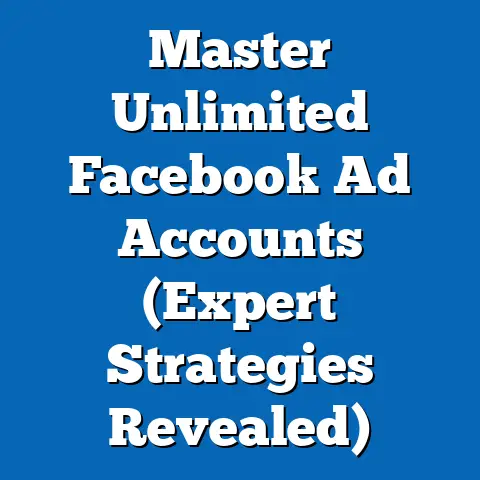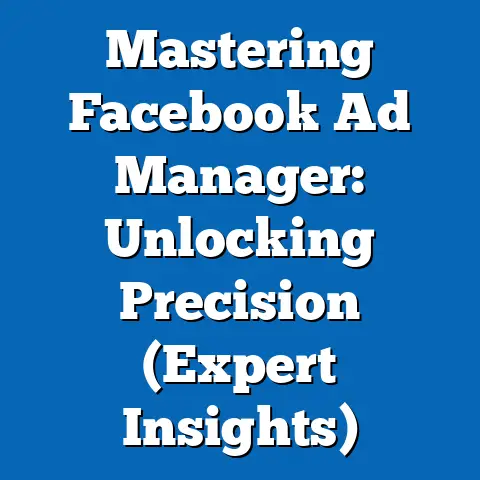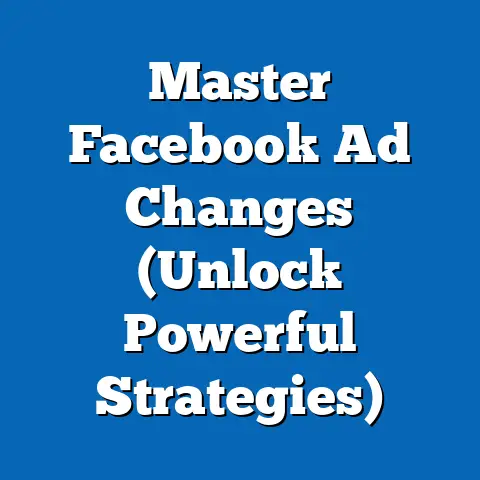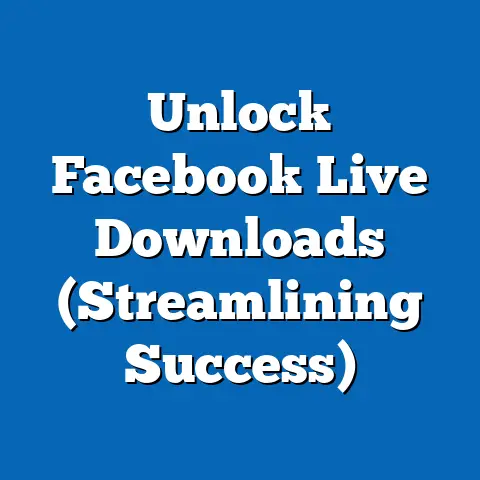How to Showcase Action in Facebook Ads (Visual Impact Tips)
I’ve spent years immersed in the world of Facebook advertising, and one thing I’ve consistently seen is that static, passive ads just don’t cut it anymore. In today’s fast-paced digital environment, you need to grab attention instantly, and that’s where showcasing action comes into play.
Think about it: We’re bombarded with ads every single day. What makes us stop scrolling? It’s the visuals that capture our eye and tell a story in a split second. And in a world increasingly focused on sustainability, showcasing action in your Facebook ads becomes even more crucial. Consumers aren’t just looking for products; they’re looking for brands that align with their values.
More than ever, users are looking for brands that are making a difference. They want to see companies actively participating in sustainable practices, and your Facebook ads are a perfect platform to demonstrate that commitment. This isn’t just about slapping a “eco-friendly” label on your product; it’s about showing the real impact of your actions.
In this article, I’m going to dive deep into how you can showcase action in your Facebook ads to create a powerful visual impact that drives engagement and conversions, especially when you’re promoting sustainability. We’ll cover everything from the psychology behind action-oriented visuals to specific techniques you can implement right away. Get ready to transform your Facebook ad strategy!
1. Understanding the Importance of Action in Advertising
So, what exactly do I mean by “showcasing action” in Facebook ads? It’s more than just using dynamic visuals. It’s about conveying movement, progress, and impact in a way that resonates with your audience. It’s about demonstrating the tangible effects of what you’re offering, particularly when it comes to sustainability.
Think of an ad for a reusable water bottle. A static image might show the bottle itself. But showcasing action would involve a video of someone filling the bottle at a mountain spring, hiking with it, and then refilling it at a public water fountain in a city, highlighting its versatility and reducing single-use plastic.
Why is this so important? Because action-oriented visuals tap into our inherent human psychology. Studies have shown that our brains are wired to respond to movement. It captures our attention, triggers our curiosity, and creates a sense of urgency.
- Attention Grabbing: In a crowded news feed, ads with action stand out. The movement immediately draws the eye.
- Emotional Connection: Action can evoke emotions more effectively than static images. Think of a video showing the positive impact of a sustainable farming initiative on a local community.
- Call to Action Amplification: When action is paired with a clear call to action, it’s more likely to prompt a response. A video showing someone easily assembling and using a solar-powered charger can be far more compelling than simply stating its benefits.
I’ve seen this firsthand with clients in the eco-tourism industry. Ads featuring stunning drone footage of people kayaking through pristine waters or participating in wildlife conservation efforts consistently outperformed ads with static images of the same locations. The dynamic visuals conveyed the experience and impact far more effectively.
Consider Patagonia, a brand that has mastered the art of showcasing action. Their ads often feature athletes engaging in outdoor activities, highlighting the durability and performance of their products while also promoting environmental stewardship. They don’t just sell clothing; they sell a lifestyle and a commitment to protecting the planet.
Key Takeaway: Showcasing action in your Facebook ads is about leveraging the power of movement and visual storytelling to capture attention, evoke emotions, and drive conversions. It’s particularly effective for brands promoting sustainability, as it allows you to demonstrate the tangible impact of your products and initiatives.
2. Key Elements of Visual Impact in Facebook Ads
To effectively showcase action, you need to master the core elements of visual impact. This isn’t just about throwing some moving images together; it’s about crafting a cohesive and compelling visual narrative.
Visual Storytelling
Storytelling is the backbone of any successful advertising campaign. It’s about creating a narrative that resonates with your audience and makes them feel connected to your brand. When it comes to showcasing action, storytelling is especially crucial.
Instead of just showing a product in use, tell a story about how that product is making a difference. If you’re selling eco-friendly cleaning products, don’t just show someone spraying a surface. Show the entire process: the before-and-after transformation, the family enjoying a clean and healthy home, and the peace of mind knowing they’re using sustainable products.
I once worked with a company that produces upcycled furniture. Their initial ads featured beautiful photos of the finished products. While the photos were aesthetically pleasing, they didn’t generate much engagement. We decided to revamp their ads to tell the story behind the furniture. We created a short video showing the process of collecting discarded materials, the skilled artisans transforming them into unique pieces, and the joy of customers receiving their one-of-a-kind furniture. The results were phenomenal. Engagement soared, and sales increased dramatically.
Practical Tip: When creating your visuals, ask yourself: What story am I trying to tell? What emotions do I want to evoke? How can I connect with my audience on a deeper level?
Color Psychology
Color is a powerful tool that can influence emotions and perceptions. Understanding color psychology is essential for creating visually impactful Facebook ads.
- Green: Often associated with nature, sustainability, and health. Perfect for brands promoting eco-friendly products or initiatives.
- Blue: Conveys trust, stability, and calmness. Ideal for brands in the renewable energy sector or those promoting water conservation.
- Yellow: Represents optimism, energy, and happiness. Great for brands promoting solar power or outdoor activities.
- Brown: Symbolizes earth, reliability, and simplicity. Suitable for brands offering organic products or those with a rustic aesthetic.
However, don’t just blindly follow these associations. Consider your brand identity and target audience. If your brand is bold and edgy, you might want to incorporate pops of vibrant colors like orange or pink to create a sense of excitement and energy.
I remember working with a sustainable fashion brand that initially used a muted color palette of greens and browns. While it aligned with their eco-friendly message, it didn’t stand out in the crowded news feed. We decided to introduce a vibrant teal as an accent color, which instantly made their ads more eye-catching and appealing to their target audience of young, fashion-conscious consumers.
Practical Tip: Experiment with different color palettes to see what resonates best with your audience. Use A/B testing to compare the performance of ads with different color schemes.
Dynamic Imagery
Dynamic imagery is all about capturing movement and energy. This can be achieved through various techniques, including:
- Action Shots: Use photos or videos of people actively using your products or services.
- Time-Lapse Videos: Showcase the progress of a project or the transformation of a product.
- Slow-Motion Footage: Highlight the details of an action or the quality of a product.
- Rotating Product Views: Show different angles and features of a product in a visually engaging way.
The key is to use real-life scenarios and relatable situations. People are more likely to connect with visuals that feel authentic and genuine.
I’ve found that incorporating user-generated content can be incredibly effective for creating dynamic imagery. For example, a brand selling hiking gear could feature photos and videos submitted by customers showcasing their adventures in the great outdoors. This not only creates a sense of community but also provides authentic and relatable visuals.
Practical Tip: Invest in high-quality equipment and editing software to create professional-looking dynamic imagery. Don’t be afraid to experiment with different techniques to see what works best for your brand.
Key Takeaway: Mastering the key elements of visual impact – storytelling, color psychology, and dynamic imagery – is essential for creating Facebook ads that effectively showcase action. By combining these elements, you can capture attention, evoke emotions, and drive conversions, especially when promoting sustainability.
3. Techniques for Showcasing Action in Facebook Ads
Now that we’ve covered the fundamentals, let’s dive into specific techniques you can use to showcase action in your Facebook ads.
Utilizing Video Content
Video is arguably the most powerful medium for showcasing action. It allows you to convey movement, emotion, and information in a way that static images simply can’t.
- Tutorials: Show viewers how to use your products or services in a step-by-step format. This is especially effective for complex or innovative products.
- Demonstrations: Highlight the key features and benefits of your products through live demonstrations. This can be particularly compelling for showcasing the durability or performance of your products.
- Testimonials: Feature real customers sharing their positive experiences with your brand. This builds trust and credibility.
- Behind-the-Scenes: Give viewers a glimpse into your company’s operations, showcasing your commitment to sustainability or ethical practices.
- Live Streams: Host live Q&A sessions, product launches, or events to engage with your audience in real-time.
I’ve seen incredible results with video ads, especially when they’re tailored to the specific interests and needs of the target audience. For example, a company selling organic baby food created a series of video ads featuring real parents sharing their experiences feeding their babies organic food. The ads were authentic, relatable, and highly effective in driving sales.
Practical Tips for Creating Compelling Video Content:
- Keep it Short and Sweet: Attention spans are short, so aim for videos that are 15-30 seconds long.
- Grab Attention Quickly: Start with a compelling hook that immediately captures the viewer’s interest.
- Use High-Quality Visuals and Audio: Invest in good equipment and editing software to create professional-looking videos.
- Optimize for Mobile: Most Facebook users watch videos on their mobile devices, so make sure your videos are optimized for mobile viewing.
- Add Captions: Many people watch videos with the sound off, so add captions to ensure your message is still conveyed.
Animation and Motion Graphics
Animation can be a powerful tool for illustrating action, especially for brands that may not have access to dynamic footage or those with complex concepts to explain.
- Explainers: Use animation to simplify complex topics or processes, such as how your company is reducing its carbon footprint.
- Product Demos: Create animated demonstrations of your products in action, highlighting their key features and benefits.
- Storytelling: Use animation to tell compelling stories that resonate with your audience.
I worked with a renewable energy company that used animation to explain the benefits of solar power in a visually engaging way. The animation showed how solar panels convert sunlight into electricity, how the electricity is used to power homes and businesses, and how the entire process reduces reliance on fossil fuels. The ad was incredibly effective in educating viewers and driving leads.
Best Practices for Using Animation:
- Keep it Simple: Don’t overload your animation with too much information or detail.
- Use Clear and Concise Language: Make sure your message is easy to understand.
- Choose a Style that Aligns with Your Brand: Your animation should reflect your brand’s personality and values.
- Optimize for Different Platforms: Make sure your animation looks good on all devices.
User-Generated Content
Incorporating user-generated content can showcase real-life actions taken by customers, thus fostering community and authenticity.
- Customer Photos and Videos: Feature photos and videos submitted by customers using your products or services.
- Reviews and Testimonials: Share positive reviews and testimonials from satisfied customers.
- Social Media Posts: Repost relevant social media posts from customers who are actively engaging with your brand.
I’ve seen brands successfully leverage user-generated content by hosting contests or campaigns that encourage customers to share their experiences. For example, a brand selling sustainable travel gear could host a contest asking customers to submit photos of their adventures using the gear. This not only generates a wealth of user-generated content but also creates a sense of community around the brand.
Tips for Leveraging User-Generated Content:
- Ask for Permission: Always ask for permission before using someone’s content.
- Give Credit: Properly credit the original creator of the content.
- Curate Carefully: Choose content that aligns with your brand’s values and messaging.
- Promote the Content: Share the content on your social media channels and in your ads.
Calls to Action (CTAs)
Strong CTAs are essential for encouraging viewers to take action after seeing your ad. Your CTA should be visually appealing, align with the action being showcased, and clearly communicate what you want viewers to do.
- Shop Now: Use this CTA to encourage viewers to purchase your products.
- Learn More: Use this CTA to direct viewers to a landing page where they can learn more about your products or services.
- Sign Up: Use this CTA to encourage viewers to subscribe to your email list or create an account.
- Donate Now: Use this CTA to encourage viewers to donate to a cause or organization.
- Get Started: Use this CTA to encourage viewers to try your products or services for free.
I’ve found that using action-oriented language in your CTAs can be highly effective. Instead of just saying “Learn More,” try saying “Discover the Benefits” or “See How It Works.”
Tips for Designing Effective CTAs:
- Make it Visually Appealing: Use a contrasting color and a clear, concise font.
- Place it Prominently: Make sure your CTA is easy to see and click.
- Use Action-Oriented Language: Tell viewers exactly what you want them to do.
- Test Different CTAs: Experiment with different CTAs to see what performs best.
Key Takeaway: By utilizing video content, animation, user-generated content, and strong CTAs, you can effectively showcase action in your Facebook ads and drive meaningful interactions with your audience. Remember to tailor your techniques to your specific brand, target audience, and advertising goals.
4. Testing and Optimizing Facebook Ads for Visual Impact
Creating visually impactful Facebook ads is an ongoing process. It’s not enough to simply create an ad and launch it. You need to continuously test and optimize your ads to ensure they’re performing at their best.
A/B Testing
A/B testing is a powerful technique for comparing different versions of your ads to see which one performs better. You can test different visual elements, such as:
- Images vs. Videos: Compare the performance of ads with static images to ads with videos.
- Different Video Lengths: Test different video lengths to see which one keeps viewers engaged the longest.
- Different CTAs: Experiment with different CTAs to see which one drives the most conversions.
- Different Headlines: Test different headlines to see which one captures the most attention.
- Different Color Palettes: Compare the performance of ads with different color schemes.
I recommend testing one element at a time to isolate the impact of each change. For example, if you’re testing different headlines, keep all other elements of the ad the same.
How to Conduct A/B Tests on Facebook:
- Create Two Versions of Your Ad: Make sure only one element is different between the two versions.
- Set Up Your Ad Campaign: Choose your target audience, budget, and schedule.
- Run Your Ads: Let your ads run for a sufficient amount of time (at least a week) to gather enough data.
- Analyze Your Results: Compare the performance of the two ads based on metrics like engagement rate, click-through rate, and conversion rate.
- Implement Your Findings: Use the results of your A/B tests to optimize your ads and improve their performance.
Analyzing Performance Metrics
Analyzing performance metrics is essential for understanding how your ads are performing and identifying areas for improvement. Key metrics to track include:
- Engagement Rate: The percentage of people who interacted with your ad (e.g., likes, comments, shares).
- Click-Through Rate (CTR): The percentage of people who clicked on your ad.
- Conversion Rate: The percentage of people who took a desired action after clicking on your ad (e.g., making a purchase, signing up for an email list).
- Cost Per Click (CPC): The average cost you pay for each click on your ad.
- Cost Per Conversion (CPC): The average cost you pay for each conversion.
- Return on Ad Spend (ROAS): The amount of revenue you generate for every dollar you spend on advertising.
I recommend setting up a dashboard to track these metrics over time. This will allow you to identify trends and patterns that can inform your optimization efforts.
Tips for Analyzing Performance Metrics:
- Set Benchmarks: Establish benchmarks for each metric based on your industry and advertising goals.
- Compare Performance Over Time: Track your metrics over time to see how your ads are performing relative to your benchmarks.
- Identify Underperforming Ads: Focus on ads that are underperforming and identify areas for improvement.
- Experiment with Different Strategies: Try different strategies to improve the performance of your ads.
- Continuously Monitor and Optimize: Advertising is an ongoing process, so continuously monitor your metrics and optimize your ads to ensure they’re performing at their best.
Iterating Based on Performance Data
The final step in the optimization process is to iterate based on performance data. This means using the insights you’ve gained from A/B testing and analyzing performance metrics to continuously improve your ads.
- Refine Your Visuals: Based on your A/B tests, refine your visuals to make them more engaging and effective.
- Adjust Your Targeting: If your ads aren’t reaching the right audience, adjust your targeting to reach a more relevant audience.
- Optimize Your Bidding: If your ads are too expensive, optimize your bidding strategy to lower your costs.
- Improve Your Landing Page: If your ads are driving traffic to a landing page that isn’t converting, improve your landing page to make it more user-friendly and persuasive.
I’ve found that the most successful advertisers are those who are willing to experiment, learn from their mistakes, and continuously optimize their ads based on data.
Key Takeaway: Testing and optimizing your Facebook ads is an ongoing process that requires a data-driven approach. By conducting A/B tests, analyzing performance metrics, and iterating based on performance data, you can continuously improve your ads and drive better results.
Conclusion
Showcasing action in your Facebook ads is no longer a nice-to-have; it’s a necessity. In today’s competitive digital landscape, you need to grab attention instantly, evoke emotions, and drive conversions. And when you’re promoting sustainability, showcasing action becomes even more crucial.
By mastering the key elements of visual impact – storytelling, color psychology, and dynamic imagery – and utilizing techniques like video content, animation, user-generated content, and strong CTAs, you can create Facebook ads that effectively showcase action and resonate with your audience.
But don’t just take my word for it. Put these tips into practice and see the results for yourself. Test different visuals, analyze your metrics, and continuously optimize your ads based on data.
Now, I challenge you to rethink your Facebook ad strategies. How can you incorporate more action into your visuals? How can you tell a more compelling story? How can you connect with your audience on a deeper level?
The future of advertising is visual, dynamic, and action-oriented. Embrace the power of showcasing action in your Facebook ads, and you’ll be well on your way to achieving your advertising goals.
So, go ahead, create those videos, design those animations, and leverage that user-generated content. Show the world the amazing things your brand is doing, and watch your engagement and conversions soar. The time to act is now!





